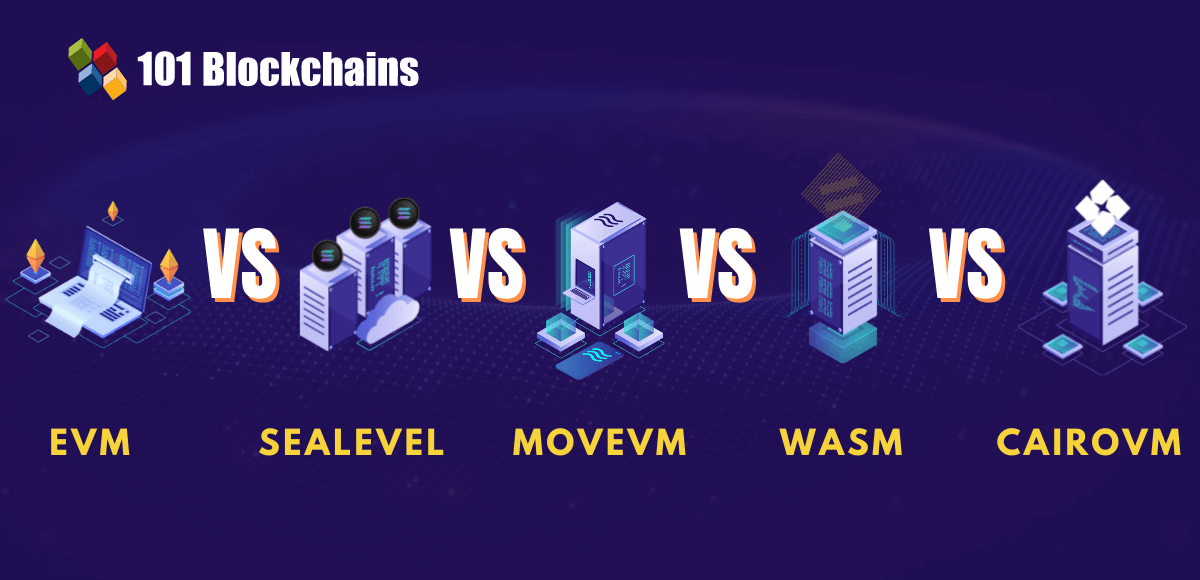Blockchain Execution Environments Comparison – 101 Blockchains

Blockchain-based dApps and many other applications have been garnering headlines for quite some time since the arrival of Bitcoin. In the early days of blockchain, the discussions about the new technology revolved around cryptocurrencies. Now, you can find many new advancements gaining traction in the blockchain and crypto ecosystem.
Whether it is DeFi or NFTs, the world of blockchain technology has a lot of surprises in store for everyone. The importance of blockchain execution environments comparison draws attention toward the choice of platforms for verifying the functionality of dApps. How is a blockchain execution environment important for developers?
What are the most popular virtual execution environments for blockchain-based apps and solutions? The following discussion offers you an outline of the top blockchain execution environments used today. Uncover the features of each blockchain execution platform and determine the ideal choice according to your requirements.
Build your identity as a certified blockchain expert with 101 Blockchains Blockchain Certifications designed to provide enhanced career prospects.
The Necessity of Blockchain Execution Environments
The term ‘blockchain execution environment’ might have led you to believe that it is a complicated concept suited for programmers. On the other hand, it is nothing more than a virtual machine, emulating the resources of a computing machine. You can come across a comparison of blockchain platforms without any idea regarding the best pick among them. Most of the abstract definitions regarding virtual machines paint them as a system or a software platform, or a mechanism.
However, the virtual machine is a program you could install on your systems and access their resources. Just because you find the term ‘blockchain’ in blockchain execution environments, you should not assume that it is a new concept specific to blockchain technology only. As a matter of fact, many of you must have used some form of virtual machine on your laptop/computer.
The simple description of blockchain execution environments suggests that they are basically virtual machines. How does the virtual machines comparison matter for developers and business leaders? The latest wave of change in the blockchain world reflects profoundly on the transition to Proof-of-Stake blockchain networks. The selection of trusted execution environments is an essential requirement in Proof of Stake blockchains. Here are some of the potential reasons why you should choose trusted execution environments.
- Better security in managing validator keys alongside the facility of disaster recovery and higher availability.
- Trusted execution environments can facilitate the execution of important code with the assurance of better integrity.
The rapid changes in the blockchain ecosystem have introduced many fundamental shifts, thereby calling for improved blockchain execution systems. How do you find the right option for your blockchain application development and deployment needs?
Want to learn blockchain technology in detail? Enroll Now in Certified Enterprise Blockchain Professional (CEBP) Course
Comparing the Popular Blockchain Execution Environments
One of the most trusted approaches for finding the best blockchain execution runtime would focus on the assessment of top choices. The EVM vs Sealevel vs MoveVM vs WASM vs CairoVM comparison might help you discover the plausible answer for your needs. Here is an overview of each blockchain execution environment and how they are different from the others.
EVM
EVM, or the Ethereum Virtual Machine, is the first virtual machine created for the purposes of blockchain development. It works as an abstraction layer isolating a physical machine from the code on the smart contract. All Ethereum nodes run an EVM instance, thereby forming an interconnected and decentralized network of nodes worldwide. You can also identify EVM as a software platform for the creation of dApps alongside executing and deploying smart contracts on Ethereum.
How does EVM stand out in the blockchain execution environments comparison, and is it reliable? The Ethereum Virtual Machine or EVM is a humongous database that can store all the accounts and balances on Ethereum. Simultaneously, EVM also serves as a machine state capable of executing machine code and adapting accordingly with the addition of new blocks to the ledger. The EVM also defines the specific rules for changes in the EVM with the addition of each new block. Here is an outline of the special highlights of Ethereum Virtual Machine, which make it a trusted blockchain execution environment.
Excited to learn the basic and advanced concepts of ethereum technology? Enroll Now in The Complete Ethereum Technology Course
The foremost highlight is the difference between EVM, Sealevel, MoveVM, WASM, and CairoVM for EVM points at isolation. EVM could ensure that the dApps are isolated from the node. As a result, the dApp and blockchain network would remain safe in event of a DDoS or virus attack on the node. At the same time, it could help in ensuring that dApps are isolated from one another, thereby safeguarding apps when a particular dApp is malicious or malfunctions.
Ethereum Virtual Machine could enable better simplicity in executing dApp transactions by converting human-readable code into commands which the nodes could understand and execute. Generally, Ethereum smart contracts have been scripted in programming languages such as Vyper and Solidity. The EVM supports the translation of code into a low-level language readable by machines with the EVM bytecode.
The comparison of blockchain platforms for the execution of dApps and smart contracts would also emphasize the gas fee estimates. EVM demands a gas fee for executing every opcode on the EVM bytecode. Gas fees are an essential requirement for security as they help in preventing DDoS attacks. For example, the cost of gas fees could mean that malicious agents would have to churn out more when they want to fill up the network with invalid transactions.
Another important highlight of EVM as a blockchain execution environment refers to its identity as a state machine. In the form of a state machine, EVM could help in figuring out the changes in the blockchain state.
The next notable feature which makes EVM stand out in a virtual machines comparison would refer to its nature as a Turing-complete VM. The EVM could solve any task you provide as input in the form of code, irrespective of time and memory limitations. At the same time, complex transactions might pile up the costs of gas fees, making it impractical to process the problem through EVM.
Want to learn the basic and advanced concepts of Ethereum? Enroll in our Ethereum Development Fundamentals Course right away!
Sealevel
The next entry in the comparison between blockchain execution environments would draw Sealevel into the equation. It is a parallel smart contracts execution environment of Solana. How does Sealevel stand out in an EVM vs Sealevel vs MoveVM vs WASM vs CairoVM comparison? You must note one significant highlight of EVM in the single-threaded design of the execution environment.
Due to the single-threaded design, EVM could allow only one contract to modify the blockchain state at one point in time. On the contrary, Solana utilizes Sealevel as an execution environment for processing thousands of smart contracts in parallel to each other. At the same time, the runtime also allows the use of multiple cores accessible to validators.
Sealevel works as the hyper-parallelized transaction processing engine for horizontal scaling throughout SSDs and GPUs. The solution behind Sealevel relies profoundly on the scatter-gather operating system driver technique. Transactions offer specifications about the state they would read and write during the execution process. The execution environment could then identify all the non-overlapping state transition functions in a block, followed by ensuring their parallel execution. At the same time, it also optimizes the scheduling of reads and writes to the state throughout an assortment of RAID 0 SSDs.
Here are some of the most important highlights about Sealevel in a comparison of blockchain execution environments.
Sealevel is a VM responsible for scheduling transactions rather than actually executing transactions in the virtual machine. On the contrary, Sealevel transfers the transactions for native execution on hardware by leveraging the Berkeley Packet Filter or BPF. The BPF is an industry-proven bytecode standard tailored for high-performance packet filters.
The outline of differences between EVM, Sealevel, MoveVM, WASM, and CairoVM would also emphasize how Sealevel offers better scalability. Sealevel can double up its computation capacity with every instance of doubling the number of available SIMD lanes. When compared to single-threaded execution environments, Sealevel has a profound advantage in ensuring scalability.
The next crucial highlight of Sealevel as a blockchain execution environment would refer to the use of LLVM. Sealevel delivers a reliable collection of tools for developers to facilitate smart contract scripting. At the same time, code written for other compilers could easily run in the Solana compiler. Therefore, developers could migrate applications from Ethereum 2.0, EOS, and Polkadot.
Start learning Ethereum with Worlds first EthereumSkill Path with quality resources tailored by industry experts Now!
MoveVM
MoveVM is another popular entry among blockchain execution environments with various distinct features. It has been developed by Libra, the blockchain arm of Facebook, and serves valid use cases in executing transactions described in Move bytecode. Developers can find two primary crates in the execution environment, which separates MoveVM in a blockchain execution environment comparison from other players.
The two primary crates in the MoveVM include the core VM and the runtime. The core VM features the low-level data type for the virtual machine, primarily with the file format and associated abstraction. Another significant detail about MoveVM refers to compliance with Move language specification through a blend of file format, runtime constraints and verification.
Here is an outline of the specific highlights of MoveVM, which could distinguish it clearly in a comparison of blockchain virtual machines.
The foremost highlight of MoveVM points at the support for Move language. It is a resource-oriented language tailored specifically for MoveVM.
The next notable feature of MoveVM points to its resource-oriented nature. Developers could use MoveVM to define a resource, placing resources under an account alongside transferring resources among accounts. At the same time, the resource-oriented nature can help in avoiding duplication, discarding, or reuse of resources.
Another striking detail in an EVM vs Sealevel vs MoveVM vs WASM vs CairoVM comparison would refer to the bytecode verification in MoveVM. MoveVM requires verification of code before execution, thereby offering the assurance for better integrity of applications.
The distinctive highlights of MoveVM also include the support for transaction-as-script. In the case of MoveVM, the transaction could feature a user script, which would be executed rather than being published as a smart contract in the blockchain. As a result, blockchain users have added flexibility and power with the opportunity to conduct multiple operations with single transactions scripted in the Move programming language.
Curious to learn about blockchain implementation and strategy for managing your blockchain projects? Enroll Now in Blockchain Technology – Implementation And Strategy Course!
WASM
The discussions on comparing different blockchain execution environments also draw attention toward WASM or Web Assembly. It is a binary instruction format tailored for stack-based virtual machines. WASM has been designed to offer a portable target to facilitate the compilation of code in high-level languages, such as Rust, C, and C++.
It is one of the most preferred execution environments for web-based deployment of client and server-side applications. The identity of WASM in a blockchain virtual machines comparison stands out profoundly with the binary format, which does not depend on the blockchain platform. As a result, it could run instructions irrespective of the machines they operate on.
Blockchain networks have to rely on determinacy to ensure effective changes according to state transition on all nodes in the network. Interestingly, WASM does not enforce the need for running similar hardware on the peer nodes in the network. Therefore, it can serve as a reliable choice for reliable interoperability while working with a potentially diverse collection of machines. Most important of all, WASM offers speed and efficiency as developers can upload it on the chain as a collection of code without any state bloat.
Here are some of the other interesting highlights about WASM as a blockchain execution environment.
-
Standard for Web Browsers
The high-performance WASM compiler has been tailored for deploying code in any browser without differences in the result. It has been designed to offer high performance, featuring similarities to the native machine code while maintaining platform-agnostic nature.
-
Support for Different Languages
The promising highlight for WASM in the difference between EVM, Sealevel, MoveVM, WASM, and CairoVM is the support for multiple smart contract programming languages. WASM extends its functionalities to many smart contract programming languages such as C, C++, C#, Rust, Kotlin, and Typescript.
-
Involvement of Major Companies
Another striking highlight for WASM focuses on the efforts by top tech companies such as Google, Facebook, Mozilla, Microsoft, and Apple for the continuous development of WASM. In addition, WASM leverages the LLVM compiler infrastructure, thereby implying the benefits of compiler optimization.
When you look at WASM, you can expect a high-performance runtime environment for blockchain-based applications and smart contracts. The blockchain execution environment assures memory safety, platform independence, and a sandboxed approach to the execution of smart contract code. On top of it, the removal of float point operations in WASM supports operations involving consensus algorithms. WASM also supports 64 and 32-bit integer operations with the facility of one-to-one mapping to CPU instructions.
Start learning Blockchain with Worlds first Blockchain Skill Paths with quality resources tailored by industry experts Now!
CairoVM
The final addition in the EVM vs Sealevel vs MoveVM vs WASM vs CairoVM comparison would draw the limelight on CairoVM. Cairo is a Turing-complete framework tailored for proving smart contract computations. Interestingly, the prominent highlight of CairoVM is evident in the exclusive set of tools it offers for users. The tools serve as promising resources for learning about Cairo and experimenting with its features alongside contributing to its development.
The four important tools offered by the Cairo framework include the compiler, the virtual machine, a tracer, and IDE extensions. Cairo compiler works on the translation of programs scripted for Cairo into Cairo bytecode. Subsequently, the CairoVM or virtual machine serves as software for taking bytecode as the input and processing it through a computer. Now, the output in this process would lead to the trace of the program, which developers can send to a STARK prover for verifying the validity of statements in Cairo code.
The other two essential highlights of CairoVM also provide a formidable boost for users. For example, the tracer in CairoVM is a unique aspect in comparison of blockchain platforms for executing and deploying code. The tracer can work as a development tool, particularly for debugging, as it can offer a visual depiction of the program’s trace as it runs on the VM.
Developers could rely on the tracer for in-depth visibility into the code execution process with effective identification of issues. On top of it, CairoVM also offers the support of IDE extensions such as Visual Studio Code and Vim. These IDE extensions help in syntax highlighting for CairoVM. Furthermore, the team behind CairoVM aims to extend the additional functionalities with new improvements in the future.
Start your blockchain journey Now with the Enterprise Blockchains Fundamentals – Free Course!
Final Words
The overview of the difference between EVM, Sealevel, MoveVM, WASM, and Cairo VM shows that each blockchain execution environment has powerful features. On the one hand, EVM appears as the popular choice for dApps and smart contract development use cases. However, it is impossible to undermine the features available with other blockchain execution environments such as Sealevel, MoveVM, CairoVM, and WASM.
For example, Sealevel could facilitate faster scalability with parallel smart contract execution. On the other hand, WASM offers support for a broad range of smart contract programming languages. Similarly, MoveVM offers a resource-oriented execution environment, while CairoVM offers additional functionalities like the tracer. Learn more about smart contract development and explore the differences between the blockchain execution environments in detail now.
*Disclaimer: The article should not be taken as, and is not intended to provide any investment advice. Claims made in this article do not constitute investment advice and should not be taken as such. 101 Blockchains shall not be responsible for any loss sustained by any person who relies on this article. Do your own research!
This article was originally reported on 101 Blockchains.








 Bitcoin
Bitcoin  Ethereum
Ethereum  Tether
Tether  Solana
Solana  USDC
USDC  Lido Staked Ether
Lido Staked Ether  XRP
XRP  Dogecoin
Dogecoin  Toncoin
Toncoin